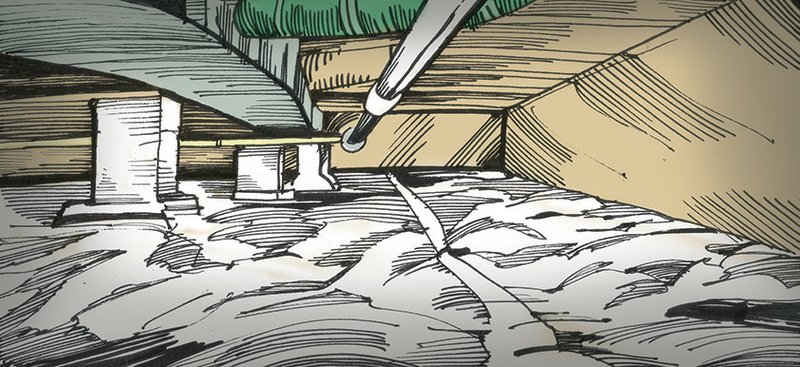An inspector from my termite company came over today and did a healthy home inspection. After he went under the crawl space, he told me I have a moisture issue and mold growing under the Visqueen. He proposes I do an encapsulation (seal off vents) and install a humidifier, which will cost $7,000. I really don't want to spend my savings on this. Are there cheaper alternatives?
"The information provided in the homeowner's question, in itself, generates a lot of other questions to ask the termite inspector," says Tim Hennelly, owner of Casa Buena home inspections of Little Rock. Those questions include:
• Are you sure the substance under the vapor retarder/barrier (aka plastic sheeting, Visqueen, polyethylene sheeting) is mold, or is it a typical nontoxic fungus?
• If it is covered by the vapor retarder, what hazard does it pose?
• What conditions changed since last year's inspection that allowed it to develop?
• If my crawl space is properly ventilated and there is no fungal growth on any wood floor structure members (such as joists, beams and sub-flooring), is there an urgent need for me to spend $7,000 to encapsulate my crawl space?
Hennelly says that his own home's crawl space is not encapsulated, but he is a proponent of encapsulating crawl spaces.
"While some may say I am hypocritical, I rather believe I am being honest and practical," he says, explaining what encapsulating a crawl space involves.
"The foundation walls will generally be insulated; a full vapor barrier [usually a multi-layer 20 mil liner] is installed from the top of the foundation walls down to and across all soil in the area; all foundation vents are sealed; and the crawl space air will be conditioned by means of a dehumidifier or introducing heat and air from the house system or by installing a vent fan to the exterior," Hennelly says.
In his 25 years of working in residential contracting and professional home inspecting, he says he has been in thousands of crawl spaces, amassed hundreds of hours in professional education seminars and professional reading, and has worked with microbiologists and indoor air quality experts.
"I can tell you that there are very few people who would argue against the benefits of encapsulating any crawl space," Hennelly says, adding, "At the same time, there are very few people who would say that the majority of crawl spaces need to be encapsulated."
Encapsulation is beneficial because it allows for control of the airspace beneath a house, helps provide more efficient heating and cooling of the interior of the house and reduces health risks for family members with allergies or breathing problems, he says.
"Of all the houses I have inspected, only about 15 had encapsulated crawl spaces," he says. "Of those, only five were done really well while the others had some deficiency such as air filtration, rodent activity or water/moisture presence."
Average installation costs to encapsulate a crawl space can range from $2,000 to $14,000 with one homeowner telling Hennelly he paid $26,000 to encapsulate a 3,000-square-foot crawl space. Aside from the quality of materials used, other factors affecting installation costs include the size of the area, considerations for heat and air equipment in a crawl space, and installation of dehumidifiers or provisions for some form of controlled ventilation.
Hennelly says he absolutely recommends that homeowners who decide to encapsulate a home's crawl space do some online research and obtain multiple estimates from contractors.
The bottom line?
"If your crawl space is free of fungal growth on wood surfaces, is relatively dry, has all of its soil covered with a vapor barrier, is well vented and does not have an adverse moisture vapor or water entry issue then you do not have an overwhelming need to encapsulate," Hennelly says.
"If your crawl space has some fungal presence, has a water entry or moisture vapor problem and lacks a vapor barrier and good ventilation, get these items cleaned, treated and corrected before you end up spending a lot more to have it encapsulated."
Those who have a crawl space with a persistent moisture problem that other measures have failed to correct, have family members with health concerns, or if fungal presence is a continual problem would most likely benefit from encapsulation, he says.
Do you have a decorating or remodeling question? We'll get you an answer from an authority. Send your question to Linda S. Haymes, Arkansas Democrat-Gazette, P.O. Box 2221, Little Rock, Ark. 72203 or email:
lhaymes@arkansasonline.com
HomeStyle on 08/15/2015
